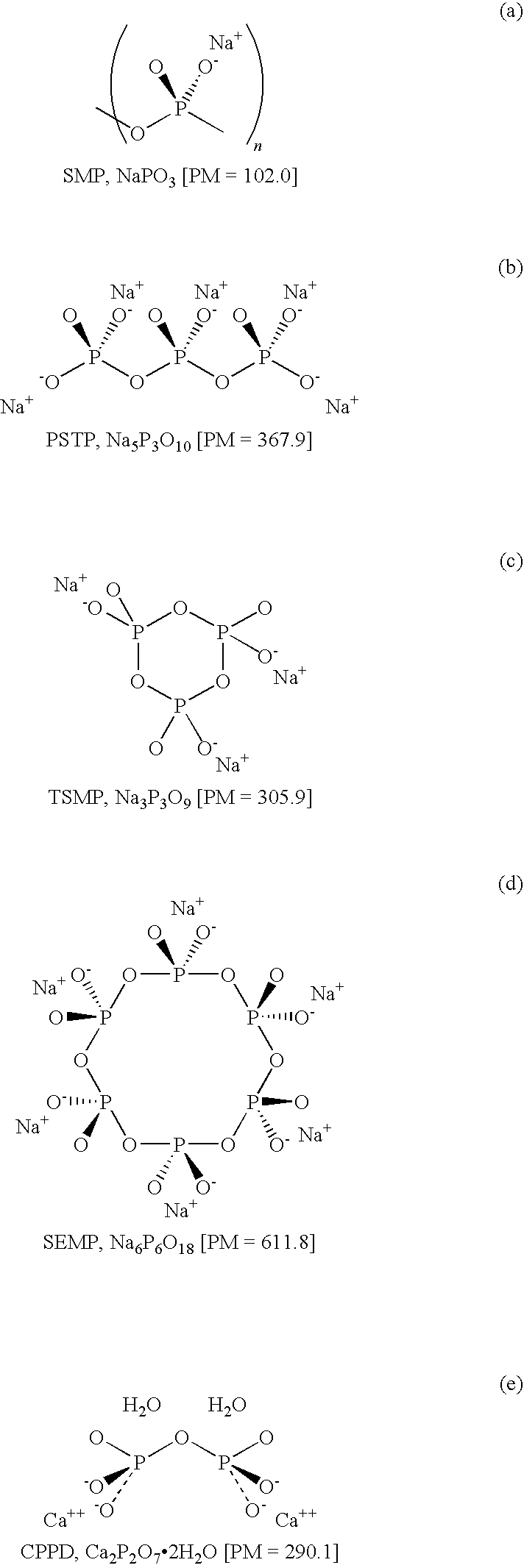Polymetaphosphate based formulations for therapy of microcrystalline arthropathies
a technology of polymetaphosphate and formulation, which is applied in the field of polymetaphosphate based formulations for the treatment of microcrystalline arthropathies, can solve the problem of insufficient lasting
- Summary
- Abstract
- Description
- Claims
- Application Information
AI Technical Summary
Problems solved by technology
Method used
Image
Examples
example 2
Measurement of Solubilizing Activity on CPPD Crystals
Description of the Solubilization Procedure and Method of Analysis
[0032]5 mg of synthetic CPPD crystals, both tricline and monocline (with average size 1-30 μm) were added to 5 ml of phosphate buffer without Ca2+ and Mg2+ (PBS) containing w different types of polymetaphosphate at the concentration of 5 mg / ml (the four solutions mentioned in Table 1.A).
[0033]The suspension was maintained at 37° C. for 1 hour under continuous agitation and subsequently filtered through 0.22 μm filters. The filtrates were subjected to analysis with spectrophotometry in atomic absorption for measurements of the final calcium concentration and the percentage of dissolution of CPPD crystals was calculated based on this data.
Solubilization Results and Conclusions
[0034]The results obtained can be summarized in the following Table 2.A.
TABLE 2.ASolubilizing effect on CPPD crystals after1 hour of incubation at 37° C. in PBSPolymetaphosphateDissolution% ofSol...
example 3
Solubilizing Effect on HAP Crystals
Description of the Solubilization Procedure and Analysis Method
[0039]With a method similar to the preceding example (using 8 mg of HAP crystals), the dissolving capacities of the formulations described in Table 1.A were also studied on synthetic microcrystals of HAP (10-20 μm).
Solubilization Results and Conclusions
[0040]The results obtained can be summarized in the following Table 3.A
TABLE 3.ASolubilizing effect on HAP crystals after1 hour of incubation at 37° C. in PBSDissolutionPolymetaphosphate(expressed in% ofSolution(5 mg / ml)mg of HAP / ml)dissolutionaPolymeric sodium0.288 (11)18.0metaphosphate (SMP)dCyclic sodium0.150 (9) 10.0hexametaphosphate (SEMP)
[0041]The results snow that capacity on HAP crystals is greater for SMP than for SEMP. In this case, as well, the values are relatively high and such as to program continuous washing procedures on articulations containing HAP calcifications.
[0042]The solubilizing capacity of polymeric sodium metapho...
example 4
Check of Cytotoxic Effect on Chondrocytes
Description of the Cytotoxicity Test
[0044]Samples of articular cartilage were obtained from the femoral heads of osteoarthritis patients subjected to hip prosthetization. Immediately after removal, portions of healthy cartilage were removed aseptically and 2 mm2 fragments were washed in physiological solution with antibiotics, then digested with 1 mg / ml of clostridial collagenase in PBS with antibiotics for 14-18 hours at 37° C. with moderate agitation. The solution was then filtered, washed in physiological solution and centrifuged. About 90-95% of the chondrocytes were found to be vital with the method of the Trypan blue vital dye, then pre-washed and left in plates with suitable culture medium at 37° C. and 5% of CO2.
[0045]The cells thus obtained were incubated with progressively greater concentrations of polymetaphosphates in PBS (pH 7.4) for 24 hours (6 wells for each tested concentration). The control culture was obtained incubating cel...
PUM
| Property | Measurement | Unit |
|---|---|---|
| Solubility (mass) | aaaaa | aaaaa |
Abstract
Description
Claims
Application Information
 Login to View More
Login to View More - R&D
- Intellectual Property
- Life Sciences
- Materials
- Tech Scout
- Unparalleled Data Quality
- Higher Quality Content
- 60% Fewer Hallucinations
Browse by: Latest US Patents, China's latest patents, Technical Efficacy Thesaurus, Application Domain, Technology Topic, Popular Technical Reports.
© 2025 PatSnap. All rights reserved.Legal|Privacy policy|Modern Slavery Act Transparency Statement|Sitemap|About US| Contact US: help@patsnap.com

